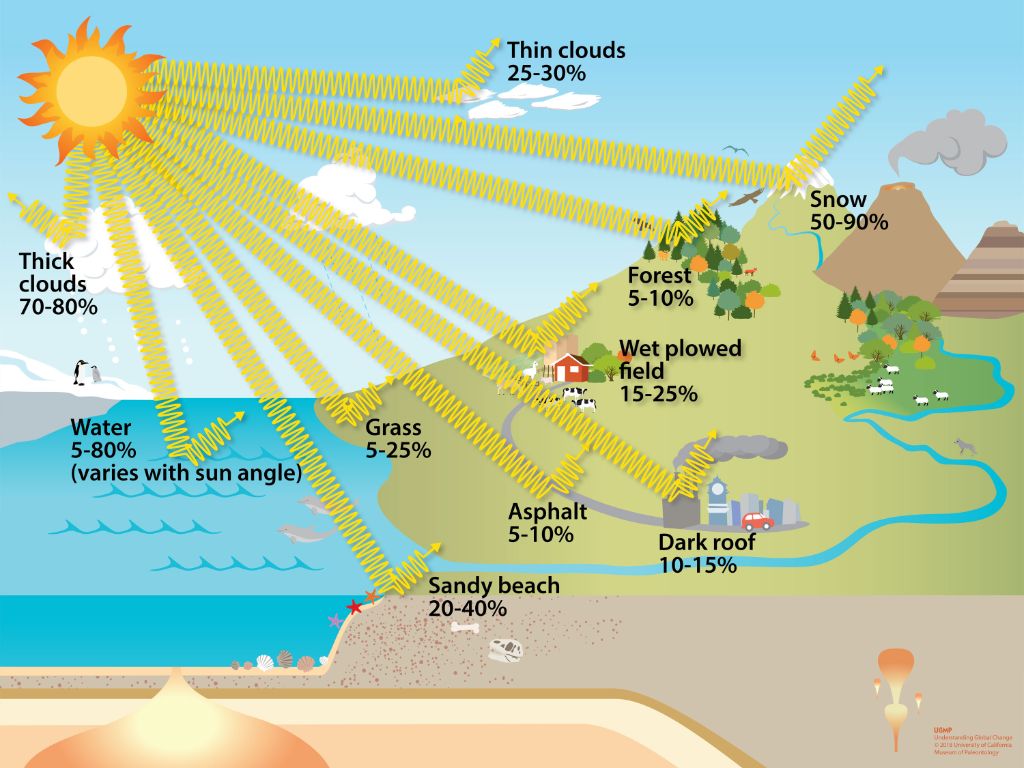How Does Solar Energy Affect Earth?

Solar energy is the radiant light and heat from the Sun that is harnessed using a range of ever-evolving technologies such as solar heating, photovoltaics, solar thermal energy, solar architecture, molten salt power plants and artificial photosynthesis (The Importance of Solar Energy). Humans have been harnessing solar energy for thousands of years, initially using passive solar design for heating, cooking and drying (The Importance of Solar Energy and How to Get Started in the Field). Today, solar energy technologies have expanded to provide renewable electricity and thermal energy worldwide. This article will examine how solar energy from the Sun affects life on Earth, from driving weather patterns to providing the energy that supports nearly all ecosystems.
The Sun’s Energy Output
The Sun produces an enormous amount of energy through the process of nuclear fusion at its core. Each second, the Sun fuses over 600 million tons of hydrogen into helium, converting over 4 million tons of matter into energy (1). This nuclear fusion process releases energy in the form of gamma rays from the Sun’s core, which interact with surrounding layers and gradually release energy in the form of photons over thousands to hundreds of thousands of years, before reaching the surface and escaping into space (2).
The total energy output of the Sun is termed solar luminosity. The Sun has a luminosity of 3.828×1026 Watts, equivalent to about 386 billion billion megawatts (1). To put this in perspective, the Sun emits the equivalent of one billion times the power usage of the entire planet, each second. This makes the Sun by far the most powerful source of energy in the solar system.
The enormous energy output of the Sun is essential for life on Earth. Solar luminosity affects Earth’s climate and provides the energy that powers biological processes like photosynthesis. Solar luminosity is relatively stable, although the Sun’s energy output does vary slightly over an 11-year solar cycle. Understanding solar luminosity helps scientists model the Sun’s role in climate and biological processes on Earth.
(1) https://en.wikipedia.org/wiki/Solar_luminosity
(2) https://link.springer.com/10.1007%2F1-4020-4520-4_374
Effects on Earth’s Climate
Solar intensity variation can have significant impacts on the Earth’s climate. According to NASA, changes in total solar irradiance correlate with past climate shifts, including the Little Ice Age between the 1600s and 1800s when solar activity was low1. Variations in solar activity affect the amount of energy from the Sun that reaches and warms the Earth.
The amount of solar energy Earth receives has followed the Sun’s natural 11-year cycle of small ups and downs with no net increase since the 1950s. Over the past century, Earth’s global average temperature has increased by around 1°C, which cannot be explained by the Sun’s 11-year cycle alone2. However, long-term patterns in solar irradiance could be having some climatic effects.
There are debates around whether low solar activity periods in the 17th century triggered the Little Ice Age’s regional cooling. Some research suggests solar variability along with volcanic activity likely played a role in climatic shifts3. Overall, variations in solar activity contribute to natural climate variability along with oceanic and atmospheric processes on Earth.
Photosynthesis
Photosynthesis is the process by which plants, algae and some bacteria convert sunlight into chemical energy that can be used by organisms. This energy conversion process relies upon solar energy from the sun. The sun emits electromagnetic radiation, including visible light, which provides the energy that powers photosynthesis.
During photosynthesis, plants and phytoplankton absorb solar energy through specialized pigments like chlorophyll. The absorbed light energy is used to drive a series of biochemical reactions that convert carbon dioxide and water into energy-rich glucose molecules and release oxygen as a byproduct.
Photosynthesis occurs in two main stages. In the first stage, light-dependent reactions capture solar energy and use it to produce ATP and NADPH. In the second stage, the light-independent reactions use these products to fix carbon dioxide into organic sugars like glucose. The entire process critically depends on solar energy from the sun to drive these reactions.
Through photosynthesis, solar energy sustains almost all life on Earth either directly or indirectly. By harnessing the sun’s energy, plants and phytoplankton provide food resources for themselves and animals while also producing oxygen. Photosynthesis is one of the most important processes on Earth fueled by the sun’s renewable energy.
[Source: https://www.nationalgeographic.org/encyclopedia/photosynthesis/]
Renewable Energy
Solar energy is considered a renewable energy source because it comes from the sun, which will continue radiating energy for billions of years. Unlike fossil fuels like coal, oil, and natural gas, solar energy does not require extracting finite resources from the earth, and it does not directly produce greenhouse gas emissions or air pollution when harnessed (1).
There are two main ways solar energy is used: solar power generation through photovoltaic panels, and solar heating/cooling through solar thermal collectors. Photovoltaic panels convert sunlight directly into electricity using semiconducting materials, while solar thermal collectors use the sun’s heat to warm air or liquid which is then used for heating, hot water, or electricity generation (2).
Compared to fossil fuel power plants, solar photovoltaics produce 90% less lifecycle greenhouse gas emissions per unit of electricity generated. Solar also enables decentralized electricity generation, avoids polluting extraction of fuels, and its modularity allows it to scale efficiently. However, solar power is intermittent and weather-dependent. Energy storage or backup capacity is often needed to provide reliable service when the sun isn’t shining (3).
Solar heating and cooling is also an emissions-free way to provide thermal energy services like space/water heating. Passive solar building design that utilizes large, south-facing windows can also substantially reduce the need for heating and lighting energy. However, solar thermal systems can be expensive to install and require adequate solar resources. They are also best suited for supplemental heating, not complete replacement of conventional systems.
(1) https://www.nationalgrid.com/stories/energy-explained/how-does-solar-power-work
(2) https://www.nationalgrid.com/stories/energy-explained/how-does-solar-power-work
(3) https://www.nationalgrid.com/stories/energy-explained/how-does-solar-power-work
Environmental Impact
Solar energy has significant environmental benefits compared to fossil fuels and nuclear energy. Unlike fossil fuel power plants, solar panels don’t produce air pollution or greenhouse gases when generating electricity (1). Solar energy systems have a positive, indirect environmental impact by offsetting emissions from electricity generation that would have occurred at other power plants. The Union of Concerned Scientists estimates that each megawatt-hour of electricity produced by a solar system results in a reduction of about 0.5 to 0.6 tons of CO2 emissions, compared to the current U.S. grid mix (2). Additionally, solar energy systems require essentially no water to produce electricity, while nuclear and coal power plants can consume billions of gallons per day.
Solar power protects the environment by reducing air pollution that harms our health and exacerbates global warming. Generating energy from the sun emits no greenhouse gases during operation, helping mitigate climate change and reducing the impact on wildlife and ecosystems (1). Unlike coal mines and offshore oil rigs, solar panels don’t disrupt habitats or cause oil spills. And while storing spent nuclear fuel can create long-term risks, solar panels can be recycled (3). Overall, solar power has an overwhelmingly positive environmental impact compared to conventional energy sources.
Sources:
(1) https://www.energy.gov/eere/solar/solar-energy-wildlife-and-environment
(2) https://www.ucsusa.org/resources/environmental-impacts-solar-power
(3) https://www.eia.gov/energyexplained/solar/solar-energy-and-the-environment.php
Challenges and Limitations
While solar energy has many advantages, it also comes with some key challenges and limitations that need to be addressed for wider adoption. One major issue is intermittency – solar energy can only be harnessed when the sun is shining. This means solar power is inconsistent and limited at certain times, like nighttime or periods of extended cloud cover. Solutions like batteries can store solar energy for use when the sun isn’t available, but storage technology is still expensive and difficult to scale up (source).
The high costs of solar are another barrier to large-scale implementation. While prices have dropped dramatically over the years, installing solar still requires significant upfront investment. Government subsidies and incentives can help offset costs, but solar energy generally remains more expensive than conventional sources like coal and natural gas. Reducing costs through technological innovations and scale will be important for competitiveness (source).
Solar farms and panels also take up considerable space, which can be problematic in densely populated areas. Rooftop solar on homes avoids this issue but comes with limits on capacity. Additionally, while solar itself is clean, manufacturing solar cells creates some pollution, and panels contain toxic materials requiring proper disposal (source).
Overall, intermittency, storage limitations, high costs, space requirements, and related environmental impacts are key challenges slowing the adoption of solar power. Ongoing research and development is focused on addressing these issues through innovations in technology, policy, and infrastructure.
Solar Energy Research
Ongoing research aims to improve the efficiency and lower the cost of solar technologies. Key research areas include advanced photovoltaic materials, concentrating solar power systems, solar integration with the utility grid, and solar forecasting techniques (NREL’s solar energy research). The U.S. Department of Energy funds solar R&D focused on photovoltaics, concentrating solar power, systems integration, and market analysis (Solar Energy Research Areas). MIT researchers are exploring new applications for solar in developing countries and ways to store solar energy for overnight use (The Future of Solar Energy). Innovations like perovskite solar cells, solar fuels, and floating solar arrays may enable greater efficiency and flexibility. Overall, research aims to make solar a more viable and cost-competitive renewable energy source.
Global Adoption
The adoption of solar energy has grown rapidly worldwide in recent years. According to the International Energy Agency, global solar photovoltaic capacity increased by 162% between 2015 and 2020, reaching 760 GW. In 2020 alone, solar PV installations increased by 23% to around 115 GW. This growth has been driven by declining costs and supportive government policies.
Some key findings on global solar adoption include:
- Asia-Pacific continues to dominate global solar installations, accounting for 55% of new capacity in 2020. China alone represented 80% of growth in the region.
- Europe’s share of global additions fell from 33% in 2015 to 14% in 2020, but remains an important market.
- The United States installed 19 GW of solar PV capacity in 2020, accounting for 17% of global additions.
- Emerging markets are playing an increasing role, with Latin America, Africa and the Middle East contributing 13% of new installations in 2020.
According to IEA forecasts, solar PV capacity is expected to reach over 4 700 GW by 2030 under current policy scenarios, a six-fold increase over 2020 levels. With additional supportive policies, adoption could accelerate even faster. Realizing this potential will require addressing barriers in developing countries and continuing to integrate large shares of solar in energy systems worldwide.
Conclusion
In summary, solar energy from the Sun has a significant impact on Earth. The Sun’s radiation powers photosynthesis in plants, enables ecosystems and the food chain, and affects Earth’s climate and weather patterns. Harnessing solar energy provides renewable power that reduces reliance on fossil fuels. While solar has limitations like intermittency and high costs, research and global adoption continue to grow. Overall, solar energy is essential to life on Earth and shows great potential to meet our energy needs in a sustainable way.







